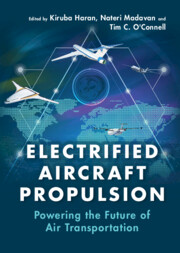Book contents
- Electrified Aircraft Propulsion
- Electrified Aircraft Propulsion
- Copyright page
- Dedication
- Contents
- Contributors
- Preface
- 1 Benefits of Electrified Propulsion for Large Aircraft
- 2 Aircraft Electric Power System Design, Control, and Protection
- 3 Megawatt-Scale Electric Machines for Electrified Aircraft Propulsion
- 4 Superconducting Machines and Cables
- 5 Conventional Power Electronics for Electrified Aircraft Propulsion
- 6 Cryogenic Power Electronics
- 7 Electrochemical Energy Storage and Conversion for Electrified Aircraft
- 8 Thermal Management of Electrified Propulsion Systems
- 9 Performance Assessment of Electrified Aircraft
- Index
- References
7 - Electrochemical Energy Storage and Conversion for Electrified Aircraft
Published online by Cambridge University Press: 11 May 2022
- Electrified Aircraft Propulsion
- Electrified Aircraft Propulsion
- Copyright page
- Dedication
- Contents
- Contributors
- Preface
- 1 Benefits of Electrified Propulsion for Large Aircraft
- 2 Aircraft Electric Power System Design, Control, and Protection
- 3 Megawatt-Scale Electric Machines for Electrified Aircraft Propulsion
- 4 Superconducting Machines and Cables
- 5 Conventional Power Electronics for Electrified Aircraft Propulsion
- 6 Cryogenic Power Electronics
- 7 Electrochemical Energy Storage and Conversion for Electrified Aircraft
- 8 Thermal Management of Electrified Propulsion Systems
- 9 Performance Assessment of Electrified Aircraft
- Index
- References
Summary
The viability of electrified aircraft propulsion (EAP) architectures, from small urban air mobility vehicles to large single-aisle transport aircraft, depends almost exclusively on their energy storage requirements. Because energy storage increases with specific energy and power density, these metrics strongly influence the adoption of EAP architectures. This chapter provides an overview of electrochemical energy storage and conversion systems for EAP, including batteries, fuel cells, supercapacitors, and multifunctional structures with energy storage capability. An overview of today’s state-of-the-art battery technology and related EAP concepts is followed by a review of energy storage requirements for various classes of electrified aircraft. Recent battery technology advances are then reviewed along with their applicability and limitations for expanding the electrified aircraft market. Alternative electrochemical energy storage and conversion systems (e.g., fuel cells, flow batteries, supercapacitors, etc.) are also addressed. The chapter concludes with a review of multifunctional structures with energy storage capability and their potential application to EAP.
Keywords
- Type
- Chapter
- Information
- Electrified Aircraft PropulsionPowering the Future of Air Transportation, pp. 190 - 223Publisher: Cambridge University PressPrint publication year: 2022
References
- 1
- Cited by



